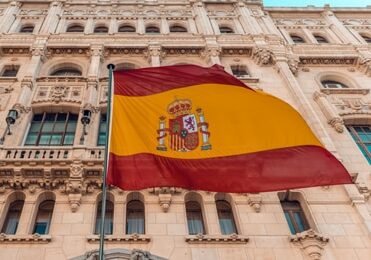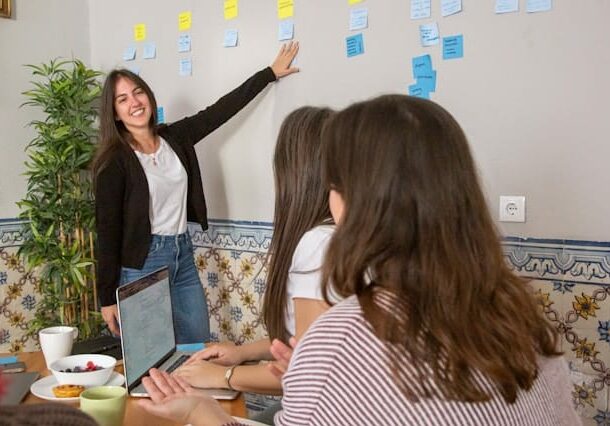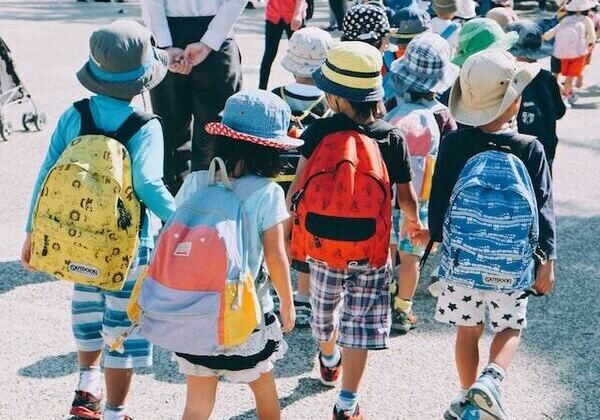
To help you in making an informed decision and simplify your planning, we’ve created this comprehensive guide to education in Spain.
Here’s what we’ll cover in this article:
- An overview of the Spanish education system
- The different levels of education in Spain
- Education in Spain for international students
- Required documentation, and more.
What's the Spanish education system like?
The Spanish education system is divided into four main categories—preschool, primary, secondary, and tertiary (also known as higher education). Naturally, students can only attend specific levels of education at a certain age. For example, a primary school in Spain is available for those from ages six to 12.
Primary and secondary school in Spain are mandatory, and your children need to attend them. In Spain, compulsory education includes only primary and secondary levels, starting at age 6 and continuing until age 16. After that, students can choose whether to pursue higher education. The mandatory education phase is free for all students attending public schools. On the other hand, preschool and higher education are completely optional. Obligatory education is free if you enroll your children in public schools. Private schools are paid, and the price will depend on how prestigious the school is and where it is located.
The quality of education in Spain is usually considered excellent, with the country being frequently listed among the top places in the world with the best international schools.
The main language spoken in schools in Spain is Spanish, but you can find international schools where students and teachers are speaking in English.
Spanish School System: Children's Ages

Here’s the breakdown of the Spanish education system and the required ages of your children to enroll in specific types of education:
- Preschool education: Students from ages 0 to six
- Primary Spanish education: Students from ages six to 12
- Secondary Spanish Education: Students from ages 12 to 16
- Spanish Baccalaureate (optional): Students from ages 16 to 18
- Vocational Spanish education (optional): Students from ages 18 and onwards
- University: Students from ages 18 and onwards
Levels of Education in Spain
Preschool education in Spain
Preschool education is meant for children from ages zero to six, and it’s divided into two separate cycles. While children from ages zero to three go to daycare centers, students from ages three to six go to early childhood education.
Daycare centers typically have their monthly fee, but in some instances, the city might provide support for these.
arly education is completely free and it focuses on preparing the children for primary education by teaching emotional development, communication, and language.
Primary education in Spain (elementary school)
Primary education lasts from ages six to 12, and it consists of three cycles or six grades. Here’s the breakdown of three primary education cycles:
- First cycle: First and second grade
- Second cycle: Third and fourth grade
- Third cycle: Fifth and sixth grade
The subjects studied in primary school include:
- Spanish language and literature
- Science (natural and social)
- Mathematics
- Physical education
- First foreign language (English)
- Arts and Crafts
- Music
- A second or third foreign language, such as French or German
- Citizenship and human rights education
- Ethical values or religion
- A regional language such as Catalan, Galician, Basque, Valencian, Aragonese, Occitan-Aranese, or Asturian
Secondary education in Spain
Secondary school in Spain (also known as middle school) takes place from ages 12 to 16, and it’s the final stage of mandatory education. It lasts for four years.
Similar to primary education, secondary education is divided into separate stages. Secondary education has two cycles:
- First cycle: First and second year
- Second cycle: Third and fourth year
The subjects during secondary education in Spain include:
- Spanish language and literature
- First foreign language (typically English)
- Biology
- Mathematics
- Physical Education
- Geography
- History
- Ethical Values or Religion
- Elective courses
In the third and fourth year of secondary education in Spain, students will get additional subjects such as physics, chemistry, Latin, and economy. During secondary education, students learn in greater detail about the subjects covered during their primary education.
Spanish baccalaureate
Spanish Baccalaureate is a completely optional education that lasts for two years, from ages 16 to 18.
Students who want to attend university should attend Spanish Baccalaureate. Once they complete this, students can start taking university entrance exams, also known as Selectividad. These exams consist of two parts—general and specific. While the general part of the exam is mandatory, the specific part entails topics of interest to the student in question. The final score consists of students’ GPA (60%) and Selectividad grade (40%).
Subjects at Spanish Baccalaureate include:
- Spanish language and literature
- First foreign language (typically English)
- Philosophy/ History of Spain
- Physical Education
- Biology
- Physics
- Geology
- Industrial technology
- Chemistry
- Business economics
- Greek
- Contemporary world history/ Universal Literature
- Geography
- Audiovisual culture
- Scenic arts
- Design
- Elective courses
Vocational Spanish education
If a child and their parents decide that university is not the right path for them, they can opt for vocational Spanish education. It’s focused on teaching students job-specific skills and it’s comprised of a network of institutions and industry partnerships.
Vocational education is not mandatory, and it’s divided into three types—basic-level vocational training, intermediate vocational training, and higher-level vocational training. Intermediate vocational training is available after completing secondary education.
At the end of their vocational Spanish education, the vocational education students obtain their diploma, which they can use to apply for jobs.
Vocational training typically lasts two to four years, depending on the student. Students can start taking the higher programs once they turn 18, and it’s basically open to all who want to learn.
Here’s the list of possible vocational training in Spain:
- Physical and sports activities
- Administration and management
- Agrarian
- Graphic arts
- Arts and crafts
- Commerce and marketing
- Electricity and electronics
- Energy and water
- Building and civil works
- Mechanical manufacturing
- Hospitality industry and tourism
- Extractive industries
- Computing and communications
- Installation and maintenance
- Personal image
- Picture and sound
- Food industries
- Wood, furniture, and cork
- Maritime/fishing industry
- Chemical
- Health
- Safety and environment
- Socio-cultural and community services
- Textile, clothing and leather
- Transport and vehicle maintenance
- Glass and ceramics
Higher education in Spain
Spain has some of the most prestigious universities in the world, such as the University of Barcelona, Pompeu Fabra University, and the University of Grenada.
Spanish universities are predominately funded by the state, but students still need to pay tuition. The price of tuition ranges from €750 to €2500 for Bachelor programs and between €1000 and €3500 for Master’s.
The prices are quite similar for both Spanish students and foreign pupils coming to Spain for a year or two. Students typically pay the tuition on a yearly basis.
It’s also important to note that Spanish citizens need to obtain the Spanish Baccalaureate diploma and pass the university entrance exam. The procedure for foreign students is a bit different, and it may vary from a university to a university.
Barcelona, Grenada, Valencia, Seville, and Madrid offer the best university studies and are typically crowded with students from all over the world. If you’re looking to enroll in university studies in one of these cities, definitely talk to your local ERASMUS coordinator. Normally, you can stay in Spain as a student for one to two semesters in a row, and you have to ensure your ECTS scores will count when you come back.
Types of Education in Spain
The Spanish education system is divided into three main categories—public, semi-private, and private schools. Public schools are funded by the country of Spain, and private schools are funded by separate entities. Semi-private schools get partial funding from the state.
Parents are free to choose which school they want to enroll their child in, but some schools may already have filled their quota and may not accept additional students.
In Spain, it’s not a regular occurrence to see students wearing uniforms in public schools, but some private schools may enforce this and provide the uniforms.
Public schools in Spain
Public schools in Spain are run and funded by either the Ministry of Education and Vocational Training or local education authorities. Given that it’s funded by the country of Spain, it’s free of charge for all students, no matter their age.
Parents must buy textbooks and other school-required items during students’ education at public schools. A complete list of books and materials is provided ahead. The cost of books and materials is normally around €300 to €400.
Semi-private schools in Spain
Semi-private schools, or colegios concertados, are a popular option within the Spanish education system. These schools are partially funded by the government, allowing them to offer a more affordable alternative to fully private institutions while still providing a high standard of education. Colegios concertados often follow the national curriculum but may incorporate additional programs, extracurricular activities, or specific educational approaches, such as religious or bilingual education.
Although tuition is generally lower than private schools, some fees may still apply for extra services, like after-school programs or supplies. Families in Spain frequently choose semi-private schools due to their reputation for delivering quality education at a reduced cost. This hybrid model of funding and structure provides a middle ground between the accessibility of public schools and the specialized offerings of private schools.
Private schools in Spain
The private education system in Spain is run by specific organizations, and it can be divided into two main categories—private schools and purely private schools. All private schools in Spain need to follow the national curriculum.
It’s important to note that all private schools have fees, and these include school supplies and uniforms (if students need to wear one).
Private schools offer both primary education and secondary education.
On top of this, parents will have more options when enrolling children in private schools in Spain. Not only can they choose from Catholic schools, but also international schools and publicly-funded private schools.
Cost of attending private schools in Spain
The cost of attending private schools in Spain, whether it entails primary education or secondary education, can be anywhere between €2000 and €20000. The private Spanish education system is supported by private entities, and that’s why the costs might be high.
Pros and Cons of Private and Public Schools in Spain
Private schools pros and cons
Pros:
- High-quality education system with ample resources
- Smaller classes and teachers can give more attention to students
- The private education system will provide uniforms, books, and materials after paying tuition
Cons:
- More expensive primary and higher education
- The lack of diversity that public and international schools provide
- Selective admission processes
Public schools pros and cons
Pros:
- The public school education system is meant for everyone, and it is free
- Students receive free transportation
- Students may participate in a larger number of activities
Cons:
- Classes are often too large
- Lack of flexibility among teachers
- Discipline issues such as bullying
International Schools in Spain

The education system also has bilingual education, which is dominant in the Basque, Catalan, Galician, and Aragonese regions.
You can find international schools all over Spain, but there you’ll have the most luck in bigger cities like Madrid and Barcelona.
The most popular international schools in Spain are British and American. It’s highly recommended you enroll your child into one of these if they struggle with integration and Spanish culture and language.
When enrolling your child into an international school, make sure to prepare all the necessary paperwork.
It’s also important to note that tuition for international schools might be costly, ranging between €2000 and €20000 a year.
Documents Required to Enroll at Schools in Spain
When enrolling a child into a school in Spain, no matter if that’s primary or secondary education, parents should provide the following documentation:
- An identification card or birth certificate
- Parents’ identification document
- Copy of the family record book
- Certificate with social security number
- Residence permit
It’s important to note that the necessary documentation may from school to school, but the Spanish education system most frequently asks for these.

Frequently Asked Questions About Education in Spain
Does Spain have a good education system?
Spain’s educational system is widely considered to be of high quality. Spain is even listed among the top ten countries worldwide with the best international schools. In short, Spain offers a variety of different levels of education, from nursery to vocational school and university education. Besides that, you can also enroll your child in an international school or Catholic school, and you can rest assured that their physical and mental skills will be well-developed.
Is education free in Spain?
The education system in Spain is designed in a way that compulsory education is completely free. That means that public primary schools and secondary Spanish schools are free of cost, but parents still have to pay for textbooks and materials needed for classes. Private schools have tuition which might vary.
How is school in Spain different from the United States?
Primary schools, as well as, secondary ones are considered compulsory education in Spain. Children might speak more than one language, especially in international school. It’s normal for children in primary schools to stay in their classes while teachers rotate. Finally, there are religious schools and other privately funded educational institutions.
What subjects are taught in Spain?
The subjects taught in Spain are typically dependent on the age of your child and if it’s attending primary, secondary, or upper secondary education. The subjects that are most frequent are the Spanish language and literature, maths, science, social sciences, and physical education.
Is school mandatory in Spain?
In Spain, children must attend school from ages 6-16, covering primary and secondary education. After turning 16, students can choose whether to continue with higher education or not. The good news is that this mandatory education is free for everyone in public schools.


